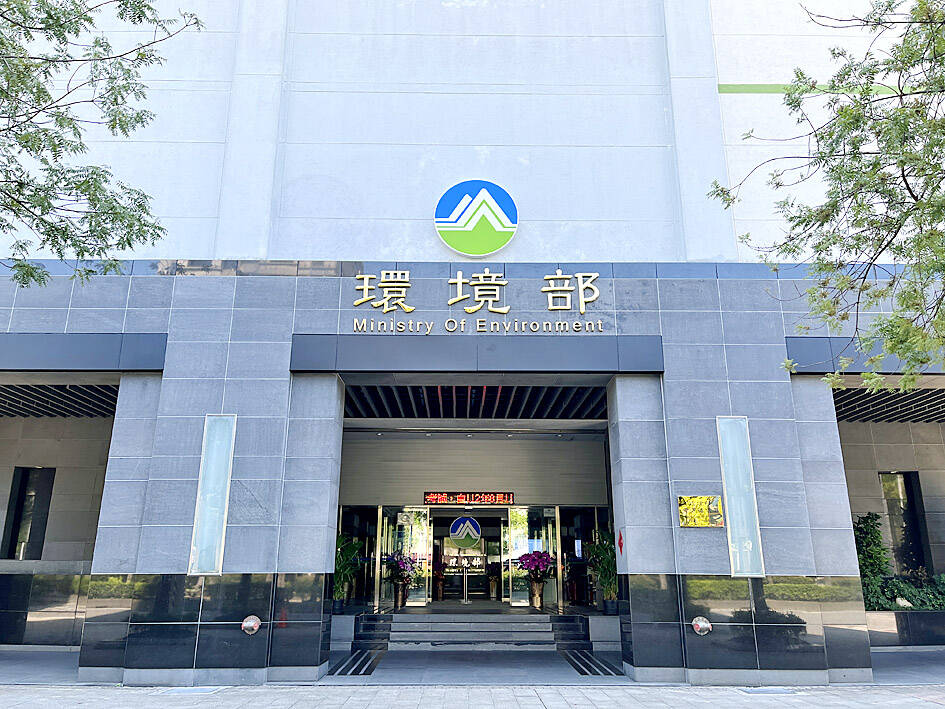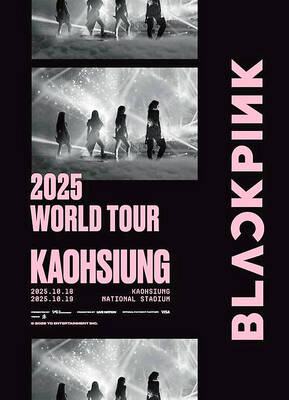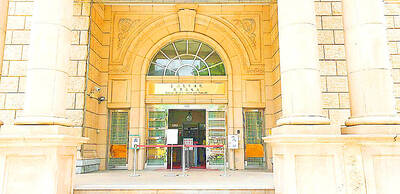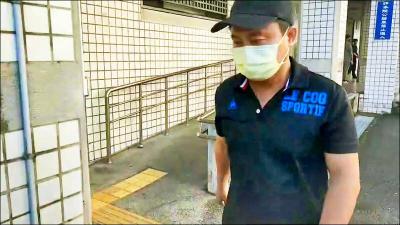The Ministry of Environment on Wednesday unveiled a carbon fee charging method that diverges significantly from what was widely expected and is less stringent on big emitters, attracting immediate criticism from environmental groups.
Climate Change Administration (CCA) Director-General Tsai Ling-yi (蔡玲儀) met with representatives from civil environmental groups at an event held by the CCA in Taipei on Wednesday.
At the meeting, Tsai said the carbon fee to be paid next year by big emitters would be their total emissions minus 25,000 tonnes of carbon dioxide equivalent (tCO2e), multiplied by the carbon fee rate (Carbon fee = (emissions - 25,000) x fee rate)).

Photo: Chen Chia-yi, Taipei Times
This came as a surprise to many of those in attendance as it had been expected that the carbon fee formula would be the fee rate multiplied by the whole amount of the carbon dioxide equivalent emitted for big emitters (Carbon fee = emissions x fee rate).
The CCA on Friday last week released the tentative outline of Taiwan’s future carbon pricing structure to be reviewed by stakeholders ahead of the publication of an official draft.
The tentative outline showed the carbon fee formula as total emissions multiplied by the carbon fee rate.
Big emitters were defined as companies whose direct and indirect annual emissions exceed 25,000 tonnes, the tentative outline shows. They were to pay carbon fees starting in 2025 based on their emissions measured this year.
An estimated 512 companies in the electricity, iron and steel, oil refining, cement, semiconductors, thin-film transistor LCD industries and all companies with direct fossil fuel emissions exceeding the 25,000-tonne threshold were to be subject to fees, the CCA said.
Wednesday’s newly publicized information amounts to granting big emitters “free allowances,” wholly at odds with what had been expected before Wednesday.
Tsai explained that the newly proposed formula is to prevent emitters from trying to avoid paying carbon fees entirely by reducing emissions to just below the 25,000 threshold.
There would have been a big difference between an emitter with 24,900 tonnes and one with 25,000 tonnes, which would have increased the incentive for companies to circumvent the regulations, Tsai said.
Based on Wednesday’s formula, carbon fees would exert insufficient pressure on companies to decarbonize, an Environmental Rights Foundation representative said.
For example, a 26,000-tonne emitter will now only have to pay NT$300,000 (US$9,672.43) if the carbon fee rate is set at NT$300 per tonne, much lower than the previously expected NT$7.8 million, the representative said.
The Society of Wilderness representative said if decarbonization is the country’s top priority, it is doubtful the current plan would make much of a contribution to ensuring firms work toward that goal.
The director-general said that of the estimated 512 big emitters, those responsible for most of the country’s emissions emit several million tonnes per year, and to them, the emission of “25,000 tonnes is like single digits.”
On the other hand, many small companies have total emissions per year of 25,000, 30,000 or 40,000 tonnes, mostly from electricity use, she added.
Such small businesses would be incentivized to use electricity more efficiently or use renewable energy if their annual emissions are only slightly above the fee threshold, Tsai said.
The CCA released the tentative outline as a pre-draft of an official draft of the regulations on Friday last week as this would allow for “wider communication with society and create a more solid consensus,” CCA Deputy Director-General Huang Wei-ming (黃偉鳴) said.
The meeting on Wednesday was the first roundtable discussion intended to facilitate wider communication.
In March last year, Chang Tzi-chin (張子敬), then-head of the Environmental Protection Administration (EPA), which was upgraded to the ministry in August last year, said about 289 big emitters collectively emitted 233.873 million tCO2e in 2021, accounting for about 82 percent of the country’s emissions.
The electricity utility companies accounted for most emissions at about 54.3 percent of the 233.873 million tCO2e, Chang said.
A report publicized by the Risk Society and Policy Research Center in June and based on information provided by the EPA, found that the top 30 enterprise-emitters, excluding electricity suppliers, emitted a total of 132.292 million tCO2e (including indirect emissions from electricity use) in 2021.
This included 10 from the petrochemical industry (49.06 percent), seven from the electronic components manufacturing sector (14.91 percent, five from the semiconductor industry and two LCD firms), five iron and steel companies (25.99 percent), four papermaking enterprises (2.8 percent), two cement firms (6.11 percent), one textile company and one glass enterprise.

South Korean K-pop girl group Blackpink are to make Kaohsiung the first stop on their Asia tour when they perform at Kaohsiung National Stadium on Oct. 18 and 19, the event organizer said yesterday. The upcoming performances will also make Blackpink the first girl group ever to perform twice at the stadium. It will be the group’s third visit to Taiwan to stage a concert. The last time Blackpink held a concert in the city was in March 2023. Their first concert in Taiwan was on March 3, 2019, at NTSU Arena (Linkou Arena). The group’s 2022-2023 “Born Pink” tour set a

The Sports Administration yesterday demanded an apology from the national table tennis association for barring 17-year-old Yeh Yi-tian (葉伊恬) from competing in the upcoming World Table Tennis (WTT) United States Smash tournament in Las Vegas this July. The sports agency said in a statement that the Chinese Taipei Table Tennis Association (CTTTA) must explain to the public why it withdrew Yeh from the WTT tournament in Las Vegas. The sports agency said it contacted the association to express its disapproval of the decision-making process after receiving a complaint from Yeh’s coach, Chuang

The Taiwan High Court yesterday upheld a lower court’s decision that ruled in favor of former president Tsai Ing-wen (蔡英文) regarding the legitimacy of her doctoral degree. The issue surrounding Tsai’s academic credentials was raised by former political talk show host Dennis Peng (彭文正) in a Facebook post in June 2019, when Tsai was seeking re-election. Peng has repeatedly accused Tsai of never completing her doctoral dissertation to get a doctoral degree in law from the London School of Economics and Political Science (LSE) in 1984. He subsequently filed a declaratory action charging that

The Hualien Branch of the High Court today sentenced the main suspect in the 2021 fatal derailment of the Taroko Express to 12 years and six months in jail in the second trial of the suspect for his role in Taiwan’s deadliest train crash. Lee Yi-hsiang (李義祥), the driver of a crane truck that fell onto the tracks and which the the Taiwan Railways Administration's (TRA) train crashed into in an accident that killed 49 people and injured 200, was sentenced to seven years and 10 months in the first trial by the Hualien District Court in 2022. Hoa Van Hao, a